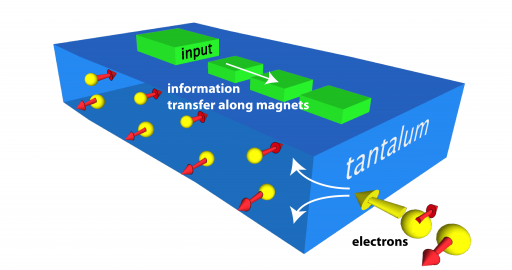Nanomagnets may replace silicon-based transistors in computers, say UC Berkeley researchers
November 20, 2013
[+]
New work by University of California Berkeley researchers could one
day make nanomagnetic switches a viable replacement for the conventional
power-consuming transistors found in all computers.
As
the current passes through a strip of tantalum, electrons with opposite
spins separate. This “clocking” helps in orienting nanomagnets (on the
top of the tantalum strip) so that they can be switched easily.
(Credit: Debanjan Bhowmik/UC Berkeley)
“Increased energy consumption of modern day computers is a major challenge that the computer industry faces,” researcher Debanjan Bhowmik explained to KurzweilAI. Bhowmik is a UC Berkeley graduate student in the Department of Electrical Engineering and Computer Sciences and the first author of a paper on this finding in Nature Nanotechnology.
“The faster the computers are, the hotter they get. This is because of a fundamental physical limit to the switching energy of a transistor, a semiconductor-based switch, which is at the heart of a computer. Nanomagnetic logic uses magnets as an ultra low energy alternative to transistors for computing because of their much sharper switching behavior.
“We project that our innovation, when implemented in the same scale as that of modern CMOS [used in transistors], would consume 10 times lower power.”
Nanomagnetic computing
For more than a decade, researchers have been pursuing magnets as an alternative to transistors because they require far less energy needs when switching. However, until now, the power needed to generate the magnetic field to orient the magnets so they can easily clock on and off has negated much of the energy savings that would have been gained by moving away from transistors.
UC Berkeley researchers overcame this limitation by exploiting the special properties of the rare heavy metal tantalum. They created a “Spin Hall effect” by using nanomagnets placed on top of tantalum wire and then sending a current through the metal. Electrons in the current will randomly spin in either a clockwise or counterclockwise direction. When the current is sent through tantalum’s atomic core, the metal’s physical properties naturally sort the electrons to opposing sides based on their direction of spin. This creates the polarization researchers exploited to switch magnets in a logic circuit without the need for a magnetic field.
“This is a breakthrough in the push for low-powered computing,” said study principal investigator Sayeef Salahuddin, UC Berkeley assistant professor of electrical engineering and computer sciences. “The power consumption we are seeing is up to 10,000 times lower than state-of-the-art schemes for nanomagnetic computing. Our experiments are the proof of concept that magnets could one day be a realistic replacement for transistors.”
The Defense Advanced Research Projects Agency, Semiconductor Research Corp. and the National Science Foundation helped support this work.
Abstract of Nature Nanotechnology paper
Spin-based computing schemes could enable new functionalities beyond those of charge-based approaches. Examples include nanomagnetic logic, where information can be processed using dipole coupled nanomagnets, as demonstrated by multi-bit computing gates. One fundamental benefit of using magnets is the possibility of a significant reduction in the energy per bit compared with conventional transistors. However, so far, practical implementations of nanomagnetic logic have been limited by the necessity to apply a magnetic field for clocking. Although the energy associated with magnetic switching itself could be very small, the energy necessary to generate the magnetic field renders the overall logic scheme uncompetitive when compared with complementary metal-oxide-semiconductor (CMOS) counterparts. Here, we demonstrate a nanomagnetic logic scheme at room temperature where the necessity for using a magnetic field clock can be completely removed by using spin-orbit torques. We construct a chain of three perpendicularly polarized CoFeB nanomagnets on top of a tantalum wire and show that an unpolarized current flowing through the wire can ‘clock’ the perpendicular magnetization to a metastable state. An input magnet can then drive the nanomagnetic chain deterministically to one of two dipole-coupled states, ‘2 up 1 down’ or ‘2 down 1 up’, depending on its own polarization. Thus, information can flow along the chain, dictated by the input magnet and clocked solely by a charge current in tantalum, without any magnetic field. A three to four order of magnitude reduction in energy dissipation is expected for our scheme when compared with state-of-the-art nanomagnetic logic.
(¯`*• Global Source and/or more resources at http://goo.gl/zvSV7 │ www.Future-Observatory.blogspot.com and on LinkeIn Group's "Becoming Aware of the Futures" at http://goo.gl/8qKBbK │ @SciCzar │ Point of Contact: www.linkedin.com/in/AndresAgostini
 Washington
Washington